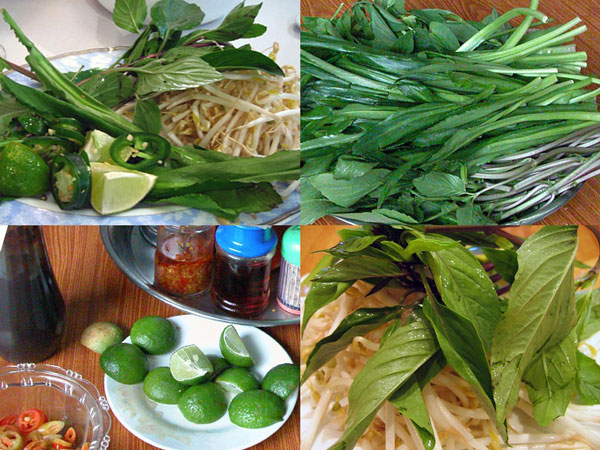Garnishes for Pho is so important to the total pho experience that our rating system treats garnishes freshness and quantity as separate point earners. Here’s vietnam-mylife’s rating system based on points on scale from 1 to 5, with 5 being best:
- Pho noodle: scale 1-5.
- Soup stock: scale 1-5.
- Meats: scale 1-5.
- Garnishes*: freshness, scale 1-5.
- Garnishes: extra points for fresh ngo gai (scale 1-5). The fresher and more in quantity, the higher the points!
- Price: scale -5 to +5 based on baseline of $5-$6 per bowl (California price) being 0 point. Lower than baseline price gets extra points, while higher prices can earn negative points!
- Extra points: scale 1-5 for general ambience of the location, including clean dining area, airy and light ambience, good reliable service, totally authentic Vietnamese ambience, etc.
So as you can see garnish can really take the total points up a notch or down a level. Garnishes have a strong impact on the total experience of enjoying a bowl of pho, and we’re serious about it. Here’s what I mean:
- Expected garnishes. We consider bean sprouts, basil, lime or lemon, and freshly sliced chiles to be must have items, and only rate them on levels of freshness from 1 to 5. Of note is the chiles or peppers. Most U.S. pho places serve sliced Mexican jalapeño in place of the smaller hot pepper varieties in Vietnam, usually served whole (unsliced). This in our view is an acceptable arrangement, and places with authentic offerings will get more points.
- We consider ngo gai (culantro) important enough to the total pho eating experience that it has its own rating. Many restaurants skipped ngo gai altogether and will get low or no points. In our view there is no excuse for not having it, and those offering lots of ngo gai will get points galore.
If you’re going to garnish your pho, only culantro, basil, sprouts, with a touch of lemon/lime will do. I’m sure the combination of taste was not developed overnight, but I’m glad someone did it, and the rest of us went for it. In the end, from the texture of the noodle and meat pieces, to the taste and heat of the soup broth, to the fresh green garnishes, with a touch of lime and heat of chile pepper, and finally the sweet and spicy touch of hoisin sauce and red hot sauce, everything just comes together nicely.
So what do you prefer when it comes to garnishing your pho? Chances are unless the restaurant you’re in identifies itself as having Pho Bac or offering Pho Bac on the menu specifically, each and every pho place you eat at will be the regular southern variety with garnishes. Share your pho garnish experience with us.







0 comments:
Post a Comment